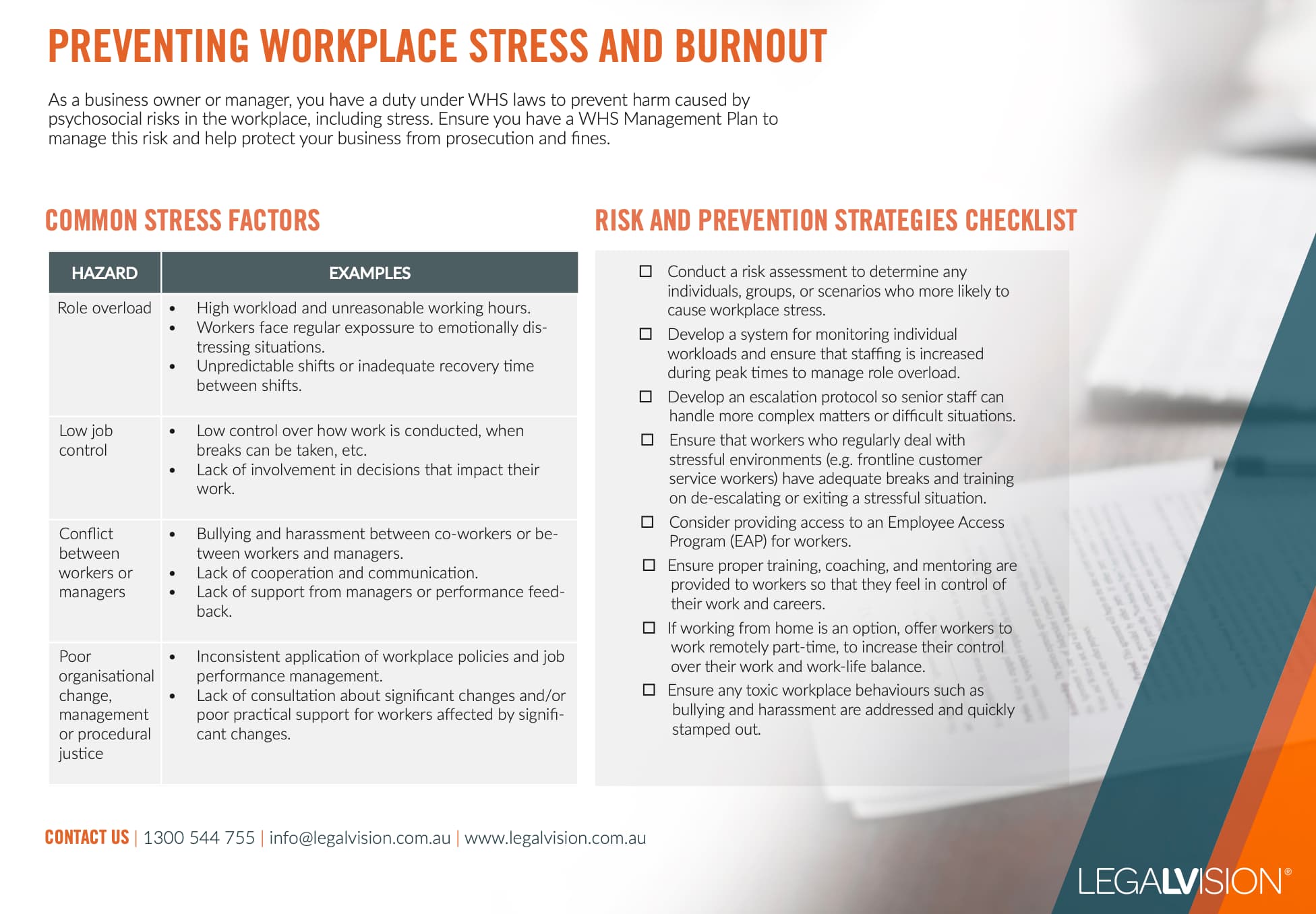In Short
- Employers must comply with WHS laws and take steps to identify and manage psychosocial hazards in the workplace.
- Common risks include stress from high workloads, poor communication, lack of support, and behaviours such as bullying or harassment.
- Regular assessments, worker consultation, and effective control measures are essential to create a safe and supportive workplace.
Tips for Businesses
Take a proactive approach to psychosocial risks by consulting employees, monitoring workloads, and reviewing workplace practices. Address issues early, provide clear job expectations, and ensure support systems are in place. A safe and supportive environment not only meets WHS obligations but also improves morale and productivity.
As an employer, it is your obligation to abide by work health and safety (WHS) laws and ensure that there are no psychosocial risks present in your workplace. Recently, there have been several amendments to WHS regulations that explicitly mention psychosocial risks as an area that you must address. The increased focus of regulators on this area is due to the high prevalence of these hazards, where there has been a noticeable rise in non-physical injuries in the workplace. This article outlines how you can review psychosocial safety risks in your business and ensure compliance with WHS laws.
What Are Some Common Psychosocial Hazards?
Common psychosocial hazards at work include various factors that can negatively affect your employee’s mental health and well-being. These factors may include:
- high workloads, tight deadlines, and excessive time pressures leading to stress and anxiety;
- insufficient support from managers and colleagues;
- inadequate training and resources that can cause frustration and feelings of isolation;
- frequent changes in job responsibilities or unclear expectations;
- poor organisational management, such as inadequate communication and consultation;
- a lack of positive feedback or an abundance of negative feedback, causing low morale and motivation;
- working in remote or isolated locations;
- difficulties with colleagues or clients, leading to conflict and tension;
- behaviours such as violence, aggression, bullying, discrimination, or harassment.
What Gives Rise to Psychosocial Hazards?
Within a business setting, there are various factors that can contribute to psychosocial risks, adversely affecting the well-being of employees. These risks can arise from the nature of the work itself, including expectations and tasks. A common hazard arises from requiring employees to accomplish an overwhelming amount of work with limited resources.
Similarly, hazards can also arise from how you manage, organise and support your employees. A work system that restricts employees from seeking help from their supervisors can expose them to hazards.
Moreover, hazards can arise from the design and layout of your working environment, including exposure to unpleasant or dangerous conditions. For instance, frequent disagreements or rude comments from colleagues or clients can create psychosocial hazards.
Continue reading this article below the formHow to Review Psychosocial Hazards in the Workplace?
Conducting a comprehensive evaluation of your business can go a long way in identifying potential risks that may be impacting productivity. This evaluation should entail a thorough examination of various aspects of your business operations, including your workforce and their roles. You should evaluate whether your employees are overworked or feel unsupported in their duties. This assessment may involve observing their behaviour, work output, and interactions with other employees.
In addition, you may need to conduct interviews or consult with your workers to gain more insight into their concerns. By doing so, you can gain a better understanding of the challenges your business faces and take appropriate steps to address them, such as:
- improving employee morale;
- redefining job roles; or
- restructuring the organisational hierarchy.

As a business owner or manager, you have a duty under WHS laws to prevent harm caused by psychosocial risks in the workplace, including stress. This factsheet outlines some common psychosocial hazards and provides a checklist for risk mitigations strategies.
How to Identify and Assess Risks in the Workplace
Identifying workplace risks involves identifying potential situations or materials that could harm people. Various factors, such as the physical work environment, equipment, materials, work tasks, and management, can lead to psychosocial risks. When assessing risks, you should also factor in how frequently workers are exposed to the hazards and how severe the hazard might be.
It’s crucial to have a proactive and constructive approach when managing these risks. This includes:
- providing a safe and healthy work environment;
- promoting worker participation; and
- implementing policies that encourage workers to report safety issues.
By doing so, you can create a positive work culture at your business where everyone feels valued, supported, and safe.
It is important to consider psychosocial hazards as a whole instead of individually. This is because it is possible for workers and others to be exposed to multiple psychosocial hazards at once, where these hazards can interact with each other. By assessing risks collectively, you may be able to identify more effective control measures.
For instance, if a worker is dealing with aggressive client behaviour, their safety is at greater risk if you or other managers do not support them.
Key Takeaways
Psychosocial hazards are common in workplaces. However, as an employer, it is your responsibility to identify and limit these risks when they arise. To help you review whether your workforce is at risk of psychosocial hazards, you should consider:
- psychosocial hazards as a whole instead of individually;
- control measures that can be implemented when employees have exposure to multiple psychosocial hazards;
- procedures for managing risks and processes through which your workers can report any issues; and
- consulting with your employees regarding their work environment, safety and expectations frequently to avoid worker fatigue and poor working conditions.
If you require legal advice regarding your WHS obligations, our experienced employment lawyers can assist as part of our LegalVision membership. For a low monthly fee, you will have unlimited access to lawyers to answer your questions and draft and review your documents. Call us today on 1800 534 315 or visit our membership page.
Frequently Asked Questions
You can identify psychosocial hazards by reviewing workloads, communication practices, and workplace culture. Observe employee behaviour and performance, and ask for feedback through surveys or interviews. Look for signs of stress, conflict, or low morale. This process helps you recognise risks early and implement suitable control measures.
You should actively address psychosocial risks by promoting open communication, providing adequate training, and ensuring managers support employees. Redefine job roles if workloads are excessive and improve workplace culture by recognising employee contributions. Encourage staff to report issues promptly and implement clear policies to reduce risks and improve well-being.
We appreciate your feedback – your submission has been successfully received.











